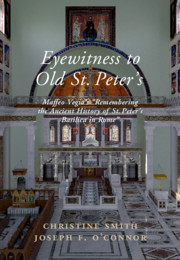 Eyewitness to Old St Peter's
Eyewitness to Old St Peter's Part I - The Canon and the Basilica
Published online by Cambridge University Press: 03 July 2019
Summary
We present “Remembering St. Peter’s” to our readers in its first English translation as an exceptionally – even uniquely – significant and consequential contribution to the history of St. Peter’s Basilica. By the descriptor “St. Peter’s Basilica,” we intend not only the material fabric and contents of that Early Christian church known to scholars as Old St. Peter’s but, more broadly, the basilica as an institution represented by the Chapter of St. Peter’s, of which Vegio was a member. The text, while no heated polemic and constituting no sustained argument for any side, is nonetheless an extended response to the transferal of pope and Curia from the cathedral of Rome, St. John Lateran, to residence at the Vatican in 1447. It sheds a great deal of new light on the Chapter of St. Peter’s, an institution that has not been much studied despite its centrality to the life of the basilica. In addition, it offers the sole eyewitness evidence for the state of the basilica just prior to its demolition (Figure 1). These contexts, which are immediately related to St. Peter’s, do not exhaust the importance of our text. Indeed, the text is an exemplar of that new Humanist historiography that, addressing both the recuperation of ancient Roman history, topography, and archeology and the lives of the saints, aimed to establish truth as its criterion as much through new uses of primary sources as through the use of new primary sources. Its instrument was a Latin prose at once correct and stylish, narrative in its ordering, thematic and ideational in its content, and rendering both dry chronicles and fantastical inventions, such as were Vegio’s own main sources, obsolete. While our translation is accurate to Vegio’s Latin, we retain the flavor of his literary style in an effort to preserve these qualities in our English text.
- Type
- Chapter
- Information
- Eyewitness to Old St Peter'sA Study of Maffeo Vegio's ‘Remembering the Ancient History of St Peter's Basilica in Rome,' with Translation and a Digital Reconstruction of the Church, pp. 1 - 118Publisher: Cambridge University PressPrint publication year: 2019


